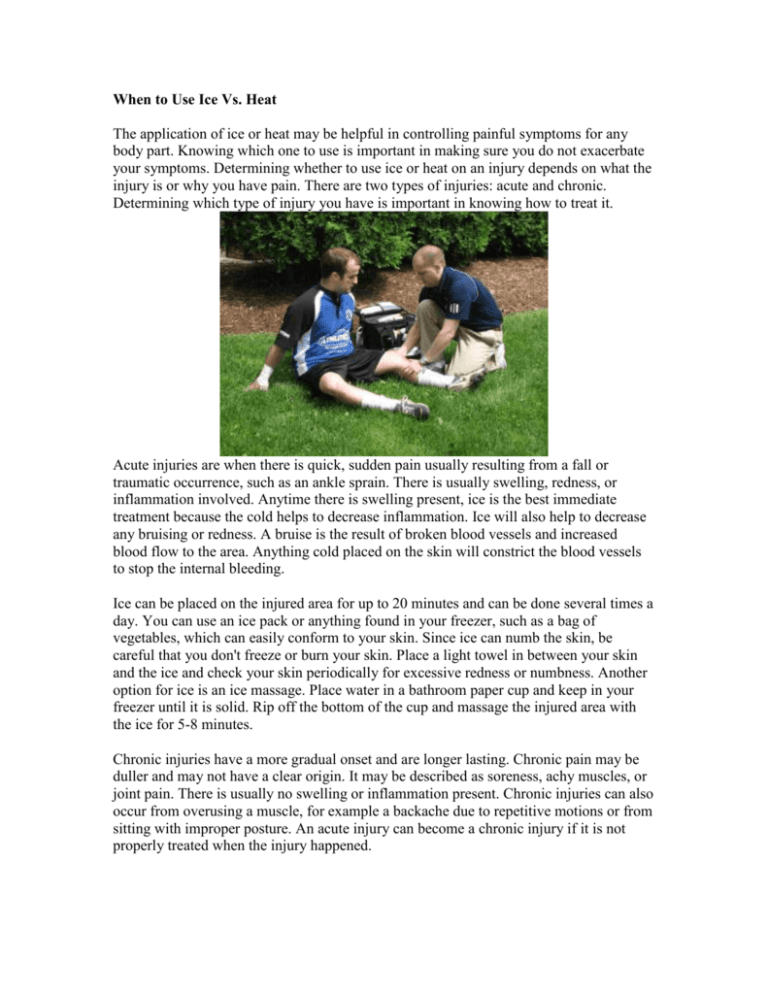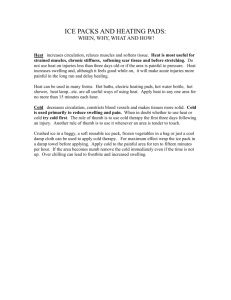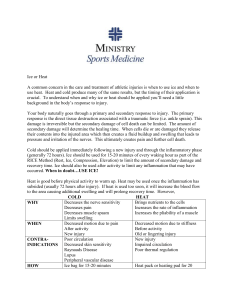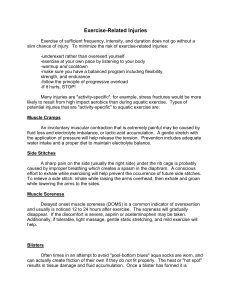When to Use Ice Vs
advertisement

When to Use Ice Vs. Heat The application of ice or heat may be helpful in controlling painful symptoms for any body part. Knowing which one to use is important in making sure you do not exacerbate your symptoms. Determining whether to use ice or heat on an injury depends on what the injury is or why you have pain. There are two types of injuries: acute and chronic. Determining which type of injury you have is important in knowing how to treat it. Acute injuries are when there is quick, sudden pain usually resulting from a fall or traumatic occurrence, such as an ankle sprain. There is usually swelling, redness, or inflammation involved. Anytime there is swelling present, ice is the best immediate treatment because the cold helps to decrease inflammation. Ice will also help to decrease any bruising or redness. A bruise is the result of broken blood vessels and increased blood flow to the area. Anything cold placed on the skin will constrict the blood vessels to stop the internal bleeding. Ice can be placed on the injured area for up to 20 minutes and can be done several times a day. You can use an ice pack or anything found in your freezer, such as a bag of vegetables, which can easily conform to your skin. Since ice can numb the skin, be careful that you don't freeze or burn your skin. Place a light towel in between your skin and the ice and check your skin periodically for excessive redness or numbness. Another option for ice is an ice massage. Place water in a bathroom paper cup and keep in your freezer until it is solid. Rip off the bottom of the cup and massage the injured area with the ice for 5-8 minutes. Chronic injuries have a more gradual onset and are longer lasting. Chronic pain may be duller and may not have a clear origin. It may be described as soreness, achy muscles, or joint pain. There is usually no swelling or inflammation present. Chronic injuries can also occur from overusing a muscle, for example a backache due to repetitive motions or from sitting with improper posture. An acute injury can become a chronic injury if it is not properly treated when the injury happened. Generally heat works better for chronic injuries. Heat helps to open up the blood vessels and increase blood flow to the area. This increased blood flow can assist in healing of a sore muscle or tendon. Heat can also help to relax a very tight muscle or muscle spasm. If there is any inflammation or swelling, don't apply heat since you don't want increased blood flow, which will make the swelling and bruising worse. As with the ice, you want to be careful that you don't burn your skin. Heat may be safely applied for 15-20 minutes. Make sure that you have enough layers between the heat and your skin, and never fall asleep on a heating pad. When can ice and heat be used together? For a chronic or overuse injury, heat may be beneficial to use before any exercise to loosen up the muscles and help them relax. Heat may also be used before exercise in an acute injury but only after the inflammation and swelling have decreased; make sure not to use heat within the first few days after an injury occurs. You can use ice after exercise for both chronic and acute injuries to help decrease any soreness to the injury. If at all you are unsure whether to use ice or heat, or if your injury does not improve in a few days, please consult your Doctor or Physical Therapist.








